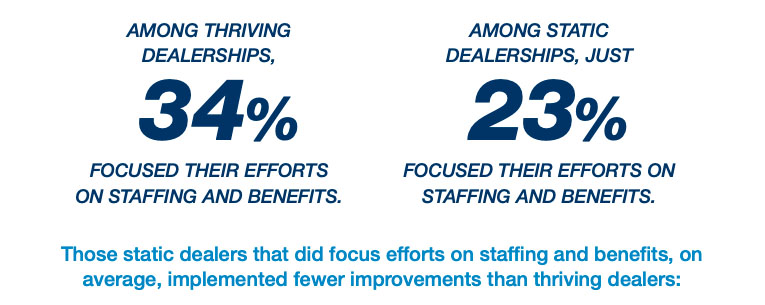Estimated reading time: 5 minutes

Leader of the pack. King of the hill. Thriver.
In 2020, the automotive sales market abruptly shifted from an in-person to a digital-first (or digital-only) business model. While many dealerships showed resilience by quickly adopting new business strategies and digital capabilities, some dealerships became even more efficient and profitable amid the challenges. These dealerships are the Thrivers.
We studied these Thrivers to learn what they did and how they did it to come out on top.
In short, they worked smarter, not harder. And they focused their time, money and resources in four key areas:
- Adapting to a digital consumer experience
- Investing in fixed ops
- Maximizing the use of data
- Prioritizing and investing in their staff
While these four areas may seem obvious, there are best practices and advantages within each of these areas to explore.
1. Adapting to a more digital consumer experience
We know that shoppers’ desire to do more online has increased over the last three years, with a shift from starting the deal online to an increased interest in finalizing the deal, making the transaction and acquiring the vehicle (home delivery) online.

82% of Thriving dealerships agree that offering more digital options to customers is critical to the retail success of any dealership and 83% agreed that the digital changes they’re making now will create long-term benefits.
By offering a digital retailing suite along with options for a traditional sales experience, you can create a seamless customer experience that extends from the digital device to the dealership.
59% of Thrivers have a strategy to incorporate digital retailing into their dealership’s sales process.
Use text, chat and virtual assistants to stay connected to your customers — they want to stay in touch and using these platforms allows you to communicate how they want and build a strong relationship throughout the car buying and owning journey.
One general manager at a Thriver dealership said, “it’s meeting the customer where they’re at, more so than we’ve had in the past. What we used to do is ask people if they wanted to opt into text messaging. And we’ve changed all our verbiage to, ‘how would you prefer to be contacted?’ And some people still prefer to be contacted via phone. We’ve had some people who said they’re on Messenger, they use WhatsApp. And so, we’ve included those as an option for our customers, as to how they prefer to interact with our staff.”
2. Invest in fixed operations
You know this. You’ve heard us shout from the mountaintops (and our blogs!) that fixed ops is a huge opportunity for stable and long-term revenue. In fact, fixed ops drives over 54%? of dealership gross profit.
Make things easy for your customer by offering convenient solutions like pickup, drop off and vehicle delivery as well as text and video quote approval. 59% of thriving dealers are dedicating time and resources to fixed operations improvements, because these incremental changes increase trust and transparency among service customers—and keep them coming back.
70% of Thrivers are using text and/or email for quote approval, including pictures and videos, while 65% are also offering service pick-up and delivery to enhance convenient solutions for customers.
3. Maximizing the use of data
Autotrader’s director of digital marketing, Kevin LeSage, often says “the most important asset dealerships own is their data.” With the changing landscape of online tracking and marketing, dealers can lean on their own data from CRMs to build custom audiences and target customers effectively.
86% of dealers agree that having accurate and complete customer data is a priority at their dealership. Armed with accurate and up-to-date information, Thrivers are moving away from mass ad campaigns in favor of targeted digital marketing.
Juggling a combination of online tracking, targeted digital marketing, transparent OEM incentives and personalized communications using data from their CRMs, these dealerships are ensuring the right messages are reaching the right customers.
“…I think that’s the key to everything right now, is making it personal. I know what you drive, I know what your service history has been. Being able to target that message and personalize everything as much as possible is helpful,” said one Thriver general sales manager.
Read more from Kevin LeSage about the state of digital marketing, including changes to third-party cookies and how to leverage your first-party data.
4. Prioritizing and investing in staff
Finding good people is hard. Keeping good people is hard. Training good people is hard. 34% of Thriving dealers focus their efforts on staffing and benefits vs. 23% of static dealers. Thrivers have focused on cross-training and career development; repositioning salespeople as showroom coordinators, facilitating digital interactions with customers and focusing on motivation and accountability. 73% of Thrivers make employee satisfaction as important as CSI scores.

And while attracting and retaining employees are key challenges for dealers, Thrivers have not been afraid to let go of staff who refuse to adapt new digital processes. They have focused on training and finding ways technology can create efficiencies, which is key to an employee’s long-term career success and allows for smoother operations internally.
The study “How to Thrive” underscores how investing in the right transformational technologies today will drive tomorrow’s better business outcomes.
See the full study, Profits & Efficiency: Implement Best Practices from Today’s Top Performing Dealerships at www.coxautoinc.com/thrivers

 ';
';


